A Role for Circular Non-Coding RNAs in the Pathogenesis of Sporadic Parathyroid Adenomas and the Impact of Gender-Specific Epigenetic Regulation
Abstract
1. Introduction
2. Materials and Methods
2.1. Sample Selection
2.2. Histopathological and Immunohistochemical Analysis
2.3. RNA Extraction from Paraffin-Embedded Tissue
2.4. Sample Labeling and Microarray Hybridization
2.5. Quantitative Real Time Reverse Transcription Polymerase Chain Reaction (qRT-PCR)
2.6. Prediction of circRNA–miRNA Interactions
Prediction of circRNA–miRNA–Target Gene Associations
2.7. Statistical Analysis
3. Results
3.1. Immunohistochemical Findings
3.2. Identification of Differential circRNA Profiles
3.3. qRT-PCR Validation of Differential circRNAs
3.4. Construction of circRNA-miRNA Network
3.5. circRNA–Genes Interactions
3.6. Parathyroid Adenomas from Male vs. Female Patients
4. Discussion
Supplementary Materials
Author Contributions
Funding
Acknowledgments
Conflicts of Interest
References
- Adami, S.; Marcocci, C.; Gatti, D. Epidemiology of primary hyperparathyroidism in Europe. J. Bone Miner. Res. 2002, 17 (Suppl. S2), N18–N23. [Google Scholar]
- Lundgren, E.; Hagstrom, E.G.; Lundin, J.; Winnerback, K.; Roos, J.; Ljunghall, S.; Rastad, J. Primary hyperparathyroidism revisited in menopausal women with serum calcium in the upper normal range at population-based screening 8 years ago. World J. Surg. 2002, 26, 931–936. [Google Scholar] [CrossRef] [PubMed]
- Fernandez-Ranvier, G.G.; Khanafshar, E.; Jensen, K.; Zarnegar, R.; Lee, J.; Kebebew, E.; Duh, Q.Y.; Clark, O.H. Parathyroid carcinoma, atypical parathyroid adenoma, or parathyromatosis? Cancer 2007, 110, 255–264. [Google Scholar] [CrossRef] [PubMed]
- Marini, F.; Cianferotti, L.; Giusti, F.; Brandi, M.L. Molecular genetics in primary hyperparathyroidism: the role of genetic tests in differential diagnosis, disease prevention strategy, and therapeutic planning. A 2017 update. Clin. Cases Miner. Bone Metab. 2017, 14, 60–70. [Google Scholar] [CrossRef] [PubMed]
- Ling, H.; Fabbri, M.; Calin, G.A. MicroRNAs and other non-coding RNAs as targets for anticancer drug development. Nat. Rev. Drug Discov. 2013, 12, 847–865. [Google Scholar] [CrossRef]
- Verdelli, C.; Forno, I.; Vaira, V.; Corbetta, S. Epigenetic alterations in human parathyroid tumors. Endocrine 2015, 49, 324–332. [Google Scholar] [CrossRef] [PubMed]
- Chen, Y.; Li, C.; Tan, C.; Liu, X. Circular RNAs: A new frontier in the study of human diseases. J. Med. Genet. 2016, 53, 359–365. [Google Scholar] [CrossRef]
- Schantz, A.; Castleman, B. Parathyroid carcinoma. A study of 70 cases. Cancer 1973, 31, 600–605. [Google Scholar] [CrossRef]
- Juhlin, C.C.; Nilsson, I.L.; Johansson, K.; Haglund, F.; Villablanca, A.; Hoog, A.; Larsson, C. Parafibromin and APC as screening markers for malignant potential in atypical parathyroid adenomas. Endocr. Pathol. 2010, 21, 166–177. [Google Scholar] [CrossRef]
- Kruijff, S.; Sidhu, S.B.; Sywak, M.S.; Gill, A.J.; Delbridge, L.W. Negative parafibromin staining predicts malignant behavior in atypical parathyroid adenomas. Ann. Surg. Oncol. 2014, 21, 426–433. [Google Scholar] [CrossRef]
- Hosny Mohammed, K.; Siddiqui, M.T.; Willis, B.C.; Zaharieva Tsvetkova, D.; Mohamed, A.; Patel, S.; Sharma, J.; Weber, C.; Cohen, C. Parafibromin, APC, and MIB-1 Are Useful Markers for Distinguishing Parathyroid Carcinomas from Adenomas. Appl. Immunohistochem. Mol. Morphol. 2017, 25, 731–735. [Google Scholar] [CrossRef] [PubMed]
- Salzman, J.; Gawad, C.; Wang, P.L.; Lacayo, N.; Brown, P.O. Circular RNAs are the predominant transcript isoform from hundreds of human genes in diverse cell types. PLoS ONE 2012, 7, e30733. [Google Scholar] [CrossRef] [PubMed]
- Sand, M.; Bechara, F.G.; Gambichler, T.; Sand, D.; Bromba, M.; Hahn, S.A.; Stockfleth, E.; Hessam, S. Circular RNA expression in cutaneous squamous cell carcinoma. J. Dermatol. Sci. 2016, 83, 210–218. [Google Scholar] [CrossRef] [PubMed]
- Dudekula, D.B.; Panda, A.C.; Grammatikakis, I.; De, S.; Abdelmohsen, K.; Gorospe, M. CircInteractome: A web tool for exploring circular RNAs and their interacting proteins and microRNAs. RNA Biol. 2016, 13, 34–42. [Google Scholar] [CrossRef] [PubMed]
- Vasef, M.A.; Brynes, R.K.; Sturm, M.; Bromley, C.; Robinson, R.A. Expression of cyclin D1 in parathyroid carcinomas, adenomas, and hyperplasias: A paraffin immunohistochemical study. Mod. Pathol. 1999, 12, 412–416. [Google Scholar] [PubMed]
- Hsi, E.D.; Zukerberg, L.R.; Yang, W.I.; Arnold, A. Cyclin D1/PRAD1 expression in parathyroid adenomas: An immunohistochemical study. J. Clin. Endocrinol. Metab. 1996, 81, 1736–1739. [Google Scholar] [CrossRef] [PubMed]
- Costa-Guda, J.; Soong, C.P.; Parekh, V.I.; Agarwal, S.K.; Arnold, A. Germline and somatic mutations in cyclin-dependent kinase inhibitor genes CDKN1A, CDKN2B, and CDKN2C in sporadic parathyroid adenomas. Horm. Cancer 2013, 4, 301–307. [Google Scholar] [CrossRef] [PubMed]
- Arya, A.K.; Bhadada, S.K.; Singh, P.; Sachdeva, N.; Saikia, U.N.; Dahiya, D.; Behera, A.; Bhansali, A.; Rao, S.D. Promoter hypermethylation inactivates CDKN2A, CDKN2B and RASSF1A genes in sporadic parathyroid adenomas. Sci. Rep. 2017, 7, 3123. [Google Scholar] [CrossRef] [PubMed]
- Costa-Guda, J.; Arnold, A. Genetic and epigenetic changes in sporadic endocrine tumors: Parathyroid tumors. Mol. Cell. Endocrinol. 2014, 386, 46–54. [Google Scholar] [CrossRef]
- Haglund, F.; Ma, R.; Huss, M.; Sulaiman, L.; Lu, M.; Nilsson, I.L.; Hoog, A.; Juhlin, C.C.; Hartman, J.; Larsson, C. Evidence of a functional estrogen receptor in parathyroid adenomas. J. Clin. Endocrinol. Metab. 2012, 97, 4631–4639. [Google Scholar] [CrossRef]
- Morris, K.V.; Mattick, J.S. The rise of regulatory RNA. Nat. Rev. Genet. 2014, 15, 423–437. [Google Scholar] [CrossRef] [PubMed]
- Barrett, S.P.; Salzman, J. Circular RNAs: Analysis, expression and potential functions. Development 2016, 143, 1838–1847. [Google Scholar] [CrossRef] [PubMed]
- Peng, N.; Shi, L.; Zhang, Q.; Hu, Y.; Wang, N.; Ye, H. Microarray profiling of circular RNAs in human papillary thyroid carcinoma. PLoS ONE 2017, 12, e0170287. [Google Scholar] [CrossRef] [PubMed]
- Li, P.; Chen, S.; Chen, H.; Mo, X.; Li, T.; Shao, Y.; Xiao, B.; Guo, J. Using circular RNA as a novel type of biomarker in the screening of gastric cancer. Clin. Chim. Acta 2015, 444, 132–136. [Google Scholar] [CrossRef] [PubMed]
- Qin, M.; Liu, G.; Huo, X.; Tao, X.; Sun, X.; Ge, Z.; Yang, J.; Fan, J.; Liu, L.; Qin, W. Hsa_circ_0001649: A circular RNA and potential novel biomarker for hepatocellular carcinoma. Cancer Biomark. 2016, 16, 161–169. [Google Scholar] [CrossRef]
- Shang, X.; Li, G.; Liu, H.; Li, T.; Liu, J.; Zhao, Q.; Wang, C. Comprehensive circular RNA profiling reveals that hsa_circ_0005075, a new circular RNA biomarker, is involved in hepatocellular crcinoma development. Medicine 2016, 95, e3811. [Google Scholar] [CrossRef] [PubMed]
- Yu, L.; Gong, X.; Sun, L.; Zhou, Q.; Lu, B.; Zhu, L. The Circular RNA Cdr1as act as an oncogene in hepatocellular carcinoma through targeting miR-7 Expression. PLoS ONE 2016, 11, e0158347. [Google Scholar] [CrossRef] [PubMed]
- Dou, Y.; Cha, D.J.; Franklin, J.L.; Higginbotham, J.N.; Jeppesen, D.K.; Weaver, A.M.; Prasad, N.; Levy, S.; Coffey, R.J.; Patton, J.G.; et al. Circular RNAs are down-regulated in KRAS mutant colon cancer cells and can be transferred to exosomes. Sci. Rep. 2016, 6, 37982. [Google Scholar] [CrossRef]
- Huang, G.; Zhu, H.; Shi, Y.; Wu, W.; Cai, H.; Chen, X. cir-ITCH plays an inhibitory role in colorectal cancer by regulating the Wnt/beta-catenin pathway. PLoS ONE 2015, 10, e0131225. [Google Scholar] [CrossRef]
- Tang, Q.; Zou, Z.; Zou, C.; Zhang, Q.; Huang, R.; Guan, X.; Li, Q.; Han, Z.; Wang, D.; Wei, H.; et al. MicroRNA-93 suppress colorectal cancer development via Wnt/beta-catenin pathway downregulating. Tumour. Biol. 2015, 36, 1701–1710. [Google Scholar] [CrossRef]
- Zhong, Z.; Lv, M.; Chen, J. Screening differential circular RNA expression profiles reveals the regulatory role of circTCF25-miR-103a-3p/miR-107-CDK6 pathway in bladder carcinoma. Sci. Rep. 2016, 6, 30919. [Google Scholar] [CrossRef] [PubMed]
- Wan, L.; Zhang, L.; Fan, K.; Cheng, Z.X.; Sun, Q.C.; Wang, J.J. Circular RNA-ITCH suppresses lung cancer proliferation via inhibiting the Wnt/beta-catenin pathway. Biomed. Res. Int. 2016, 2016, 1579490. [Google Scholar] [CrossRef] [PubMed]
- Zhao, Z.; Li, X.; Gao, C.; Jian, D.; Hao, P.; Rao, L.; Li, M. Peripheral blood circular RNA hsa_circ_0124644 can be used as a diagnostic biomarker of coronary artery disease. Sci. Rep. 2017, 7, 39918. [Google Scholar] [CrossRef] [PubMed]
- Lukiw, W.J. Circular RNA (circRNA) in Alzheimer’s disease (AD). Front. Genet. 2013, 4, 307. [Google Scholar] [CrossRef] [PubMed]
- Zhao, Z.; Li, X.; Jian, D.; Hao, P.; Rao, L.; Li, M. Hsa_circ_0054633 in peripheral blood can be used as a diagnostic biomarker of pre-diabetes and type 2 diabetes mellitus. Acta Diabetol. 2017, 54, 237–245. [Google Scholar] [CrossRef] [PubMed]
- Xu, H.; Guo, S.; Li, W.; Yu, P. The circular RNA Cdr1as, via miR-7 and its targets, regulates insulin transcription and secretion in islet cells. Sci. Rep. 2015, 5, 12453. [Google Scholar] [CrossRef]
- Greene, J.; Baird, A.M.; Brady, L.; Lim, M.; Gray, S.G.; McDermott, R.; Finn, S.P. Circular RNAs: Biogenesis, Function and Role in Human Diseases. Front. Mol. Biosci. 2017, 4, 38. [Google Scholar] [CrossRef] [PubMed]
- Ashwal-Fluss, R.; Meyer, M.; Pamudurti, N.R.; Ivanov, A.; Bartok, O.; Hanan, M.; Evantal, N.; Memczak, S.; Rajewsky, N.; Kadener, S. circRNA biogenesis competes with pre-mRNA splicing. Mol. Cell. 2014, 56, 55–66. [Google Scholar] [CrossRef]
- Hansen, T.B.; Wiklund, E.D.; Bramsen, J.B.; Villadsen, S.B.; Statham, A.L.; Clark, S.J.; Kjems, J. miRNA-dependent gene silencing involving Ago2-mediated cleavage of a circular antisense RNA. EMBO J. 2011, 30, 4414–4422. [Google Scholar] [CrossRef]
- Garneau, N.L.; Wilusz, J.; Wilusz, C.J. The highways and byways of mRNA decay. Nat. Rev. Mol. Cell Biol. 2007, 8, 113–126. [Google Scholar] [CrossRef]
- Neff, A.T.; Lee, J.Y.; Wilusz, J.; Tian, B.; Wilusz, C.J. Global analysis reveals multiple pathways for unique regulation of mRNA decay in induced pluripotent stem cells. Genome Res. 2012, 22, 1457–1467. [Google Scholar] [CrossRef] [PubMed]
- Rahbari, R.; Holloway, A.K.; He, M.; Khanafshar, E.; Clark, O.H.; Kebebew, E. Identification of differentially expressed microRNA in parathyroid tumors. Ann. Surg. Oncol. 2011, 18, 1158–1165. [Google Scholar] [CrossRef] [PubMed]
- Vaira, V.; Elli, F.; Forno, I.; Guarnieri, V.; Verdelli, C.; Ferrero, S.; Scillitani, A.; Vicentini, L.; Cetani, F.; Mantovani, G.; et al. The microRNA cluster C19MC is deregulated in parathyroid tumours. J. Mol. Endocrinol. 2012, 49, 115–124. [Google Scholar] [CrossRef] [PubMed]
- Luzi, E.; Marini, F.; Giusti, F.; Galli, G.; Cavalli, L.; Brandi, M.L. The negative feedback-loop between the oncomir Mir-24-1 and menin modulates the Men1 tumorigenesis by mimicking the “Knudson’s second hit”. PLoS ONE 2012, 7, e39767. [Google Scholar] [CrossRef] [PubMed]
- Tanic, M.; Yanowski, K.; Gomez-Lopez, G.; Rodriguez-Pinilla, M.S.; Marquez-Rodas, I.; Osorio, A.; Pisano, D.G.; Martinez-Delgado, B.; Benitez, J. MicroRNA expression signatures for the prediction of BRCA1/2 mutation-associated hereditary breast cancer in paraffin-embedded formalin-fixed breast tumors. Int. J. Cancer 2015, 136, 593–602. [Google Scholar] [CrossRef] [PubMed]
- Xu, J.; Tian, S.; Yin, Z.; Wu, S.; Liu, L.; Qian, Y.; Pei, D.; Gao, W.; Xu, J.; Yin, Y.; et al. MicroRNA-binding site SNPs in deregulated genes are associated with clinical outcome of non-small cell lung cancer. Lung Cancer 2014, 85, 442–448. [Google Scholar] [CrossRef] [PubMed]
- Jyonouchi, H.; Geng, L.; Streck, D.L.; Dermody, J.J.; Toruner, G.A. MicroRNA expression changes in association with changes in interleukin-1ss/interleukin10 ratios produced by monocytes in autism spectrum disorders: Their association with neuropsychiatric symptoms and comorbid conditions (observational study). J. Neuroinflammation 2017, 14, 229. [Google Scholar] [CrossRef] [PubMed]
- Panganiban, R.P.; Pinkerton, M.H.; Maru, S.Y.; Jefferson, S.J.; Roff, A.N.; Ishmael, F.T. Differential microRNA epression in asthma and the role of miR-1248 in regulation of IL-5. Am. J. Clin. Exp. Immunol. 2012, 1, 154–165. [Google Scholar] [PubMed]
- Noren Hooten, N.; Fitzpatrick, M.; Wood, W.H., 3rd; De, S.; Ejiogu, N.; Zhang, Y.; Mattison, J.A.; Becker, K.G.; Zonderman, A.B.; Evans, M.K. Age-related changes in microRNA levels in serum. Aging (Albany NY) 2013, 5, 725–740. [Google Scholar] [CrossRef]
- Juhlin, C.C.; Haglund, F.; Villablanca, A.; Forsberg, L.; Sandelin, K.; Branstrom, R.; Larsson, C.; Hoog, A. Loss of expression for the Wnt pathway components adenomatous polyposis coli and glycogen synthase kinase 3-beta in parathyroid carcinomas. Int. J. Oncol. 2009, 34, 481–492. [Google Scholar]
- Svedlund, J.; Auren, M.; Sundstrom, M.; Dralle, H.; Akerstrom, G.; Bjorklund, P.; Westin, G. Aberrant WNT/beta-catenin signaling in parathyroid carcinoma. Mol. Cancer 2010, 9, 294. [Google Scholar] [CrossRef] [PubMed]
- Juhlin, C.C.; Kiss, N.B.; Villablanca, A.; Haglund, F.; Nordenstrom, J.; Hoog, A.; Larsson, C. Frequent promoter hypermethylation of the APC and RASSF1A tumour suppressors in parathyroid tumours. PLoS ONE 2010, 5, e9472. [Google Scholar] [CrossRef] [PubMed]
- Svedlund, J.; Koskinen Edblom, S.; Marquez, V.E.; Akerstrom, G.; Bjorklund, P.; Westin, G. Hypermethylated in cancer 1 (HIC1), a tumor suppressor gene epigenetically deregulated in hyperparathyroid tumors by histone H3 lysine modification. J. Clin. Endocrinol. Metab. 2012, 97, E1307–E1315. [Google Scholar] [CrossRef] [PubMed]
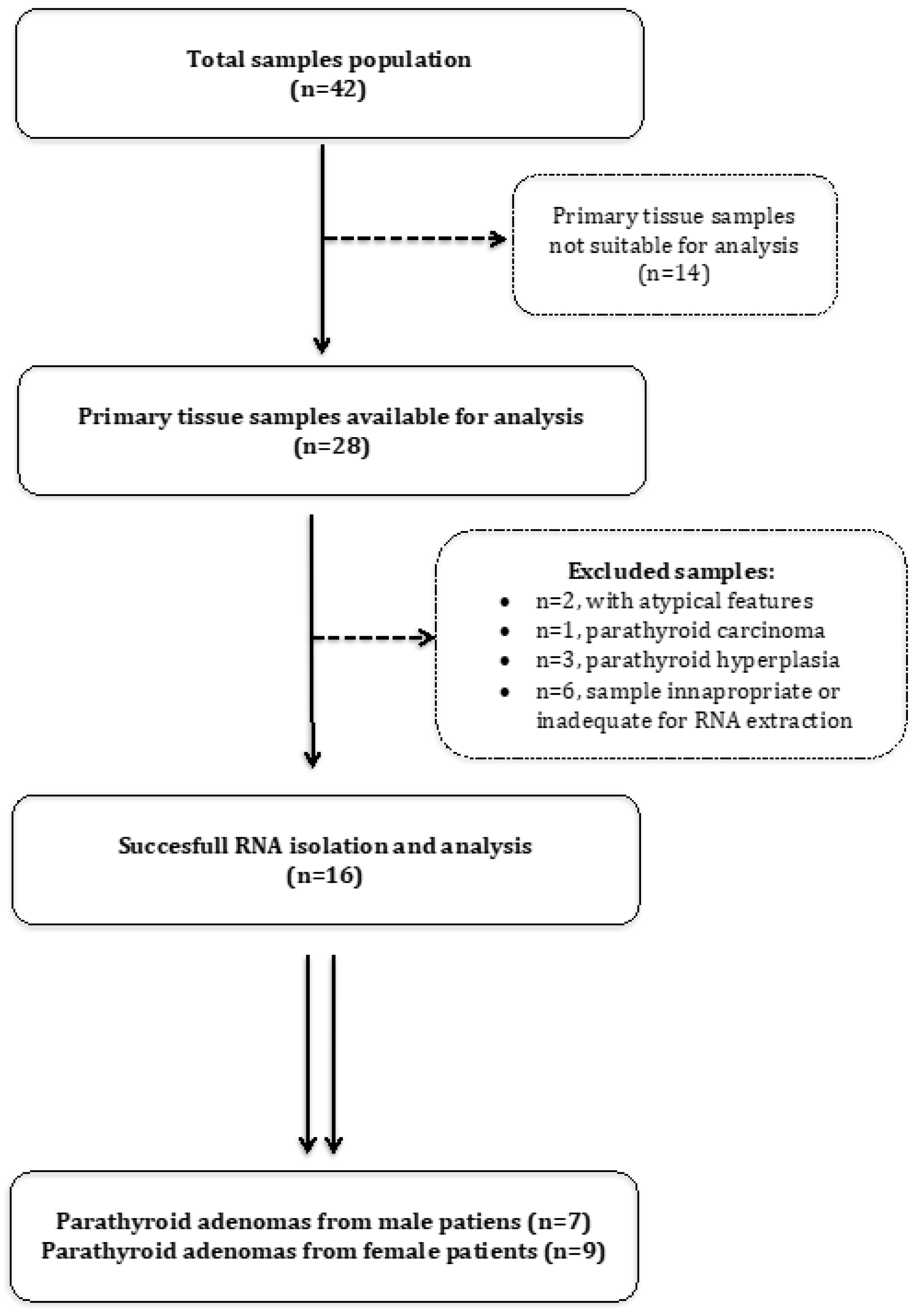
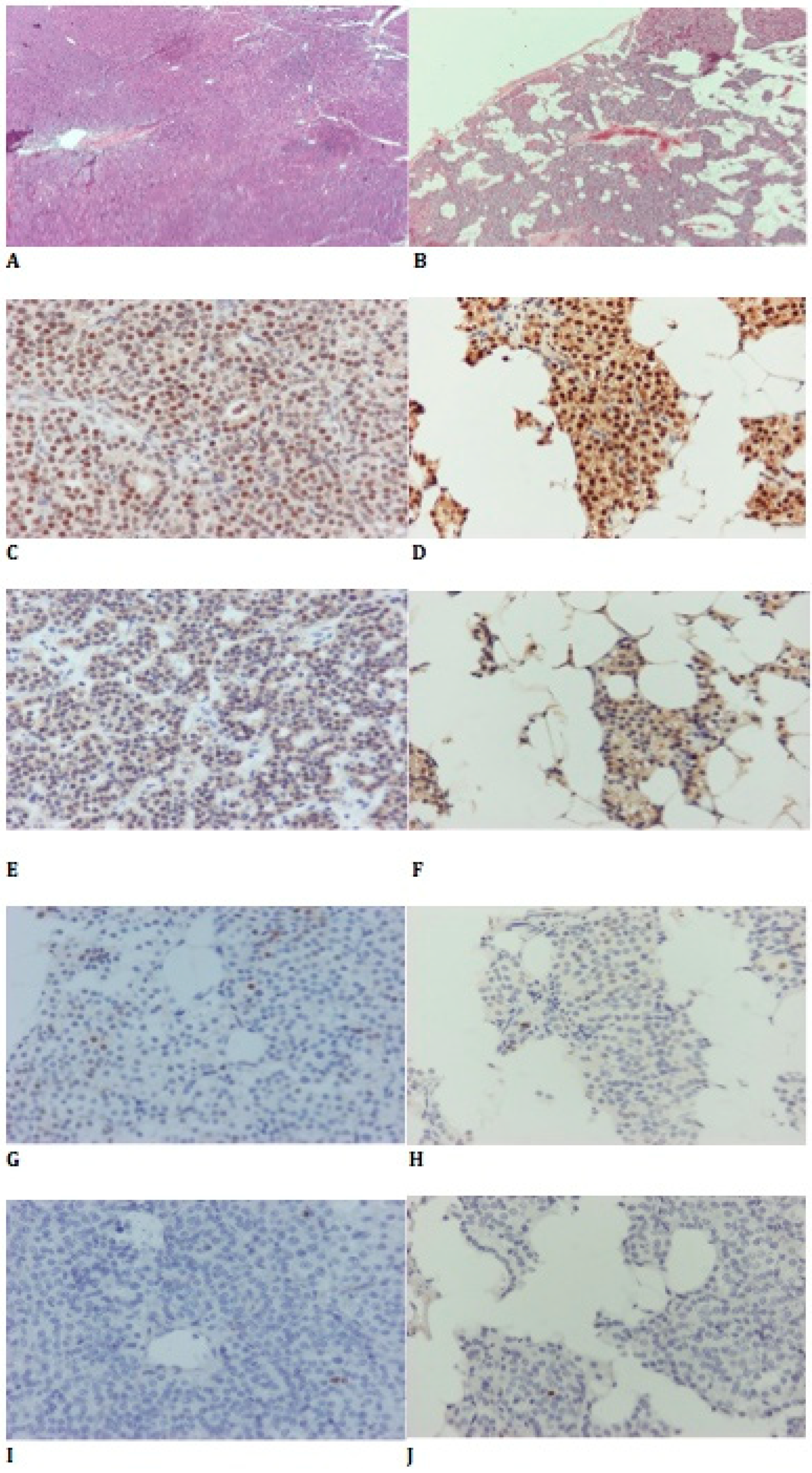
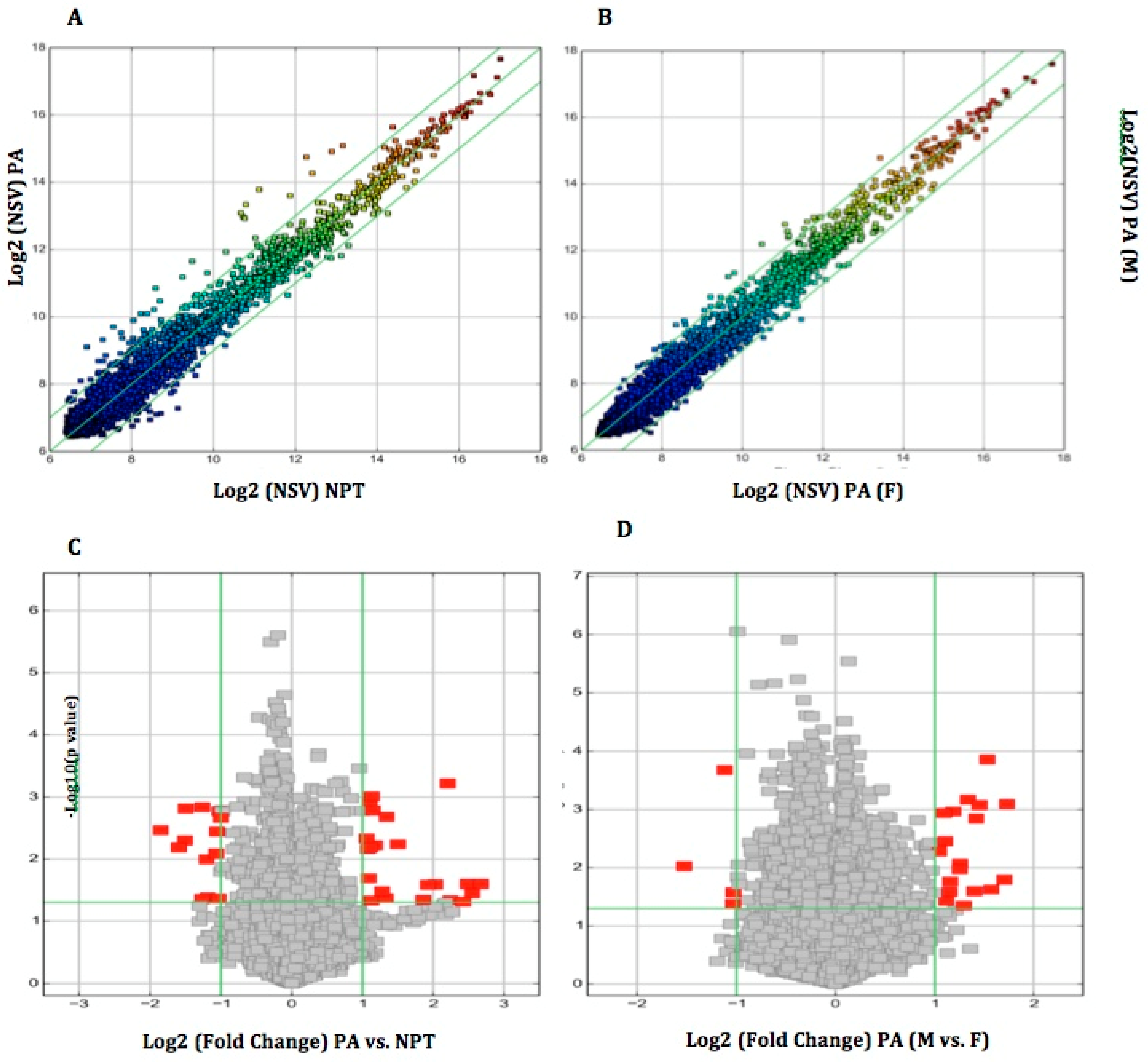
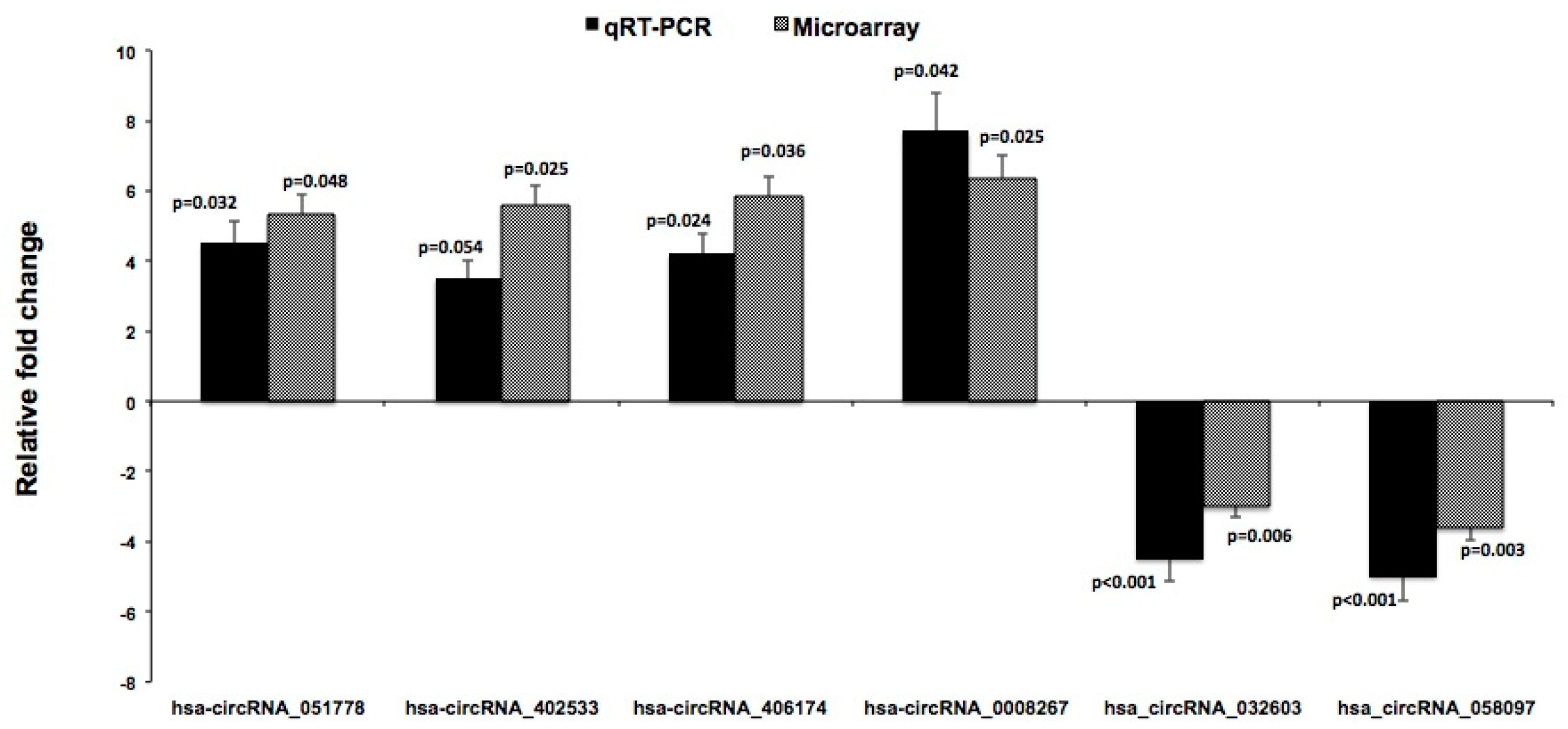
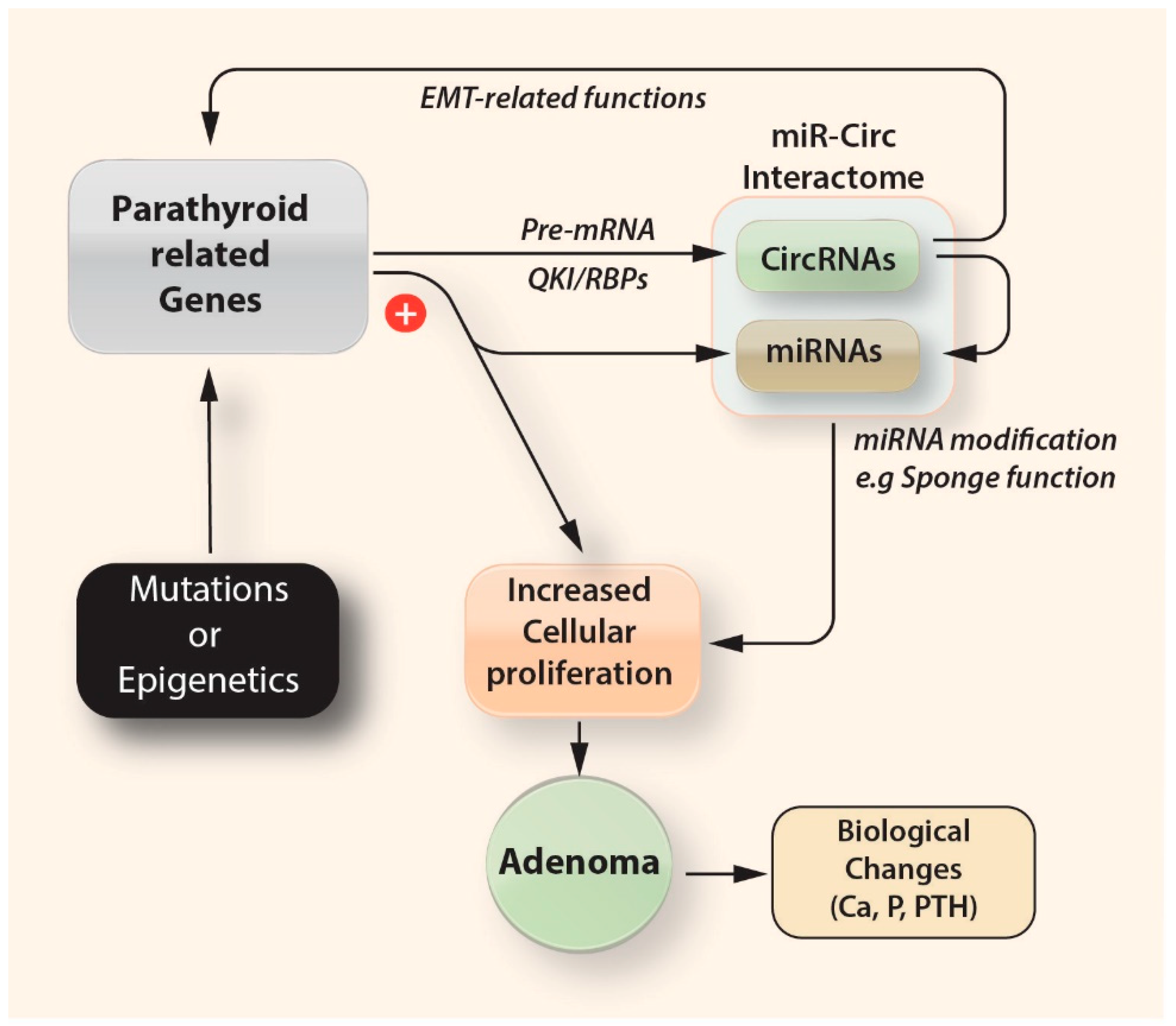
| Patient Code | Age | Baseline Values * | Post-PTX Values # | ||||
|---|---|---|---|---|---|---|---|
| s Ca | sPO4 | iPTH | s Ca | sPO4 | iPTH | ||
| NR: 2.10–2.50 mmol/L | NR: 1.0–1.5 mmol/L | NR: 1.4–6.8 pmol/L | NR: 2.1–2.5 mmol/L | NR: 1.0–1.5 mmol/L | NR: 1.4–6.8 pmol/L | ||
| Di_M_27 | 54 | 3.11 | 1.2 | 18.4 | 2.63 | 1.9 | 0.6 |
| Di_M_28 | 64 | 2.72 | 1.4 | 7.6 | 2.65 | 2 | 1.2 |
| Di_M_32 | 70 | 2.71 | 0.9 | 18.7 | 2.9 | 1.5 | 1.5 |
| Di_M_35 | 48 | 2.85 | 1.23 | 11.6 | 2.3 | 1.2 | 0.6 |
| Di_M_36 | 48 | 3.08 | 1.09 | 12.9 | 2.31 | 1.43 | 1.7 |
| Di_M_37 | 78 | 2.63 | 1.1 | 18.5 | 1.88 | 1.67 | 1 |
| Di_M_38 | 56 | 2.68 | 1.4 | 11.5 | 2.23 | 1.8 | 2.2 |
| Di_F_9 | 65 | 3.27 | 1.5 | 12.7 | 2.63 | 1.39 | 0.6 |
| Di_F_10 | 65 | 2.75 | 1.4 | 12.1 | 2.31 | 1.44 | 0.6 |
| Di_F_11 | 58 | 2.74 | 0.9 | 16.2 | 2.45 | 1.23 | 4.2 |
| Di_F_12 | 58 | 2.69 | 1.2 | 10.3 | 2.2 | 1.3 | 3.5 |
| Di_F_14 | 67 | 2.68 | 1.12 | 9.5 | 1.93 | 1.3 | 0.6 |
| Di_F_15 | 67 | 2.48 | 1.16 | 13.4 | 1.9 | 1.6 | 3.4 |
| Di_F_20 | 58 | 2.64 | 1.22 | 10.8 | 2.34 | 1.48 | 2.8 |
| Di_F_21 | 57 | 2.75 | 1.1 | 8.6 | 2.14 | 1.65 | 1.4 |
| Di_F_34 | 52 | 2.63 | 1.09 | 10.2 | 2.09 | 1.3 | 4.3 |
| Con_1M | 65 | 2.23 | 1.4 | 4.3 | / | / | / |
| Con_2M | 71 | 2.41 | 1.45 | 3.8 | / | / | / |
| Con_3F | 65 | 2.19 | 1.32 | 4.4 | / | / | / |
| Con_4F | 62 | 2.29 | 1.25 | 5.2 | / | / | / |
| CircRNA | CircRNA ID ‡ | Fold Change | p Value | FDR | Chr.Gene/Symbol | hsa-miRNA targets ‡‡ |
|---|---|---|---|---|---|---|
| Up-regulated CircRNAs | ||||||
| hsa-CircRNA_102904 | hsa_Circ_0008459 | 4.6 | 0.001 | 0.126 | KANSL1L/C2orf67(Chr.2) | 139-5p, 520f, 144, 1206, 146b-3p |
| hsa-CircRNA_404337 | hsa_Circ_0140094 | 2.14 | 0.001 | 0.148 | RPS6KA3 (Chr. X) | 1248, 1261,1264, 331-3p, 623, 644 |
| hsa-CircRNA_043614 | hsa_Circ_0043614 | 2.18 | 0.046 | 0.482 | KRT14 (chr.17) | 1184, 1205, 338-3p, 361-3p, 1224-3p, 766 |
| hsa-CircRNA_102903 | hsa_Circ_0002617 | 2.26 | 0.006 | 0.23 | KANSL1L/C2orf67 (Chr.2) | 127-5p, 1290, 139-5p, 149, 409-3p |
| hsa-CircRNA_100965 | hsa_Circ_0024501 | 2.21 | 0.002 | 0.153 | DDX6 (Chr.11) | 1248, 1251, 1264, 577, 607, 660 |
| hsa-CircRNA_001379 | hsa_Circ_0000516 | 2.11 | 0.007 | 0.234 | RPPH1 (Chr.14) | 1296 |
| hsa-CircRNA_402533 ** | - | 5.58 | 0.025 | 0.387 | OVOL2 (Chr.20) | 500b-3p |
| hsa-CircRNA_003949 | hsa_Circ_0003949 | 2.83 | 0.006 | 0.23 | PTN (Chr.7) | 1256, 145, 326, 330-5p, 620 |
| hsa-CircRNA_102116 | hsa_Circ_0003258 | 3.79 | 0.026 | 0.392 | ZNF652 (Chr.17) | 502-5p, 203, 1278, 653, 766 |
| hsa-CircRNA_404504 | hsa_Circ_0141586 | 2.43 | 0.033 | 0.424 | STIL (Chr.1) | - |
| hsa-CircRNA_051778 | hsa_Circ_0051778 | 5.34 | 0.048 | 0.487 | BCAT2 (Chr.19) | - |
| hsa-CircRNA_400537 | hsa_Circ_0093450 | 2.08 | 0.005 | 0.223 | MASTL (Chr.10) | 1236, 1279, 1825,223, 346, 520 |
| hsa-CircRNA_101283 | hsa_Circ_0030586 | 2.51 | 0.043 | 0.465 | ABCC4 (Chr.13) | 1238, 1248, 217, 651, 767-5p, 139-5p |
| hsa-CircRNA_007273 | hsa_Circ_0007273 | 2.19 | 0.001 | 0.146 | RAB11FIP5 (chr.2) | 1243, 1248, 1288, 361-3p, 876-3p |
| hsa-CircRNA_401782 | hsa_Circ_0043138 | 4.71 | 0.046 | 0.479 | TAF15 (Chr.17) | 1257, 556-5p, 758, 1282, 767-3p |
| hsa-CircRNA_002122 | hsa_Circ_0002122 | 4.07 | 0.025 | 0.391 | CTCF (Chr.16) | 1264, 136, 561, 644, 874 |
| hsa-CircRNA_002617 | hsa_Circ_0002617 | 2.13 | 0.02 | 0.36 | KANSL1L/C2orf67 (Chr.2) | 127-5p, 1290, 139-5p, 149, 409, |
| hsa-CircRNA_406174 *** | hsa_Circ_0005622 | 5.84 | 0.036 | 0.436 | PITPNB (Chr.22) | 604, 589, 1248, 593, 1248 |
| hsa-CircRNA_104269 | hsa_Circ_0078768 | 2.16 | 0.006 | 0.234 | FAM120B (Chr.6) | 1292, 661,1182, 1272, 1322 |
| hsa-CircRNA_004286 | hsa_Circ_0004286 | 2.53 | 0.002 | 0.162 | SUSD1 (Chr.9) | 1299, 182,31, 330-3p, 384 |
| hsa-CircRNA_406165 | - | 3.62 | 0.045 | 0.477 | COL6A2 (Chr.21) | - |
| hsa-CircRNA_008267 | hsa_Circ_0008267 | 6.36 | 0.025 | 0.387 | LINC00969/SDHAP2(Chr.3) | 145, 1304, 198,498, 581 |
| Down-regulated CircRNAs | ||||||
| hsa-CircRNA_404643 | hsa_Circ_0111746 | 2.31 | 0.01 | 0.272 | PIK3C2B (Chr.1) | 1224-3p, 1272, 1280, 486-3p, 586 |
| hsa-CircRNA_105038 | hsa_Circ_0105038 | 2.84 | 0.005 | 0.229 | FLNA (Chr. X) | 1225-3p, 1247, 149, 486-3p, 661 |
| hsa-CircRNA_101474 | hsa_Circ_0101474 | 2.03 | 0.002 | 0.153 | THBS1 (Chr.15) | 1322, 507, 557, 578, 615-5p, 663b |
| hsa-CircRNA_405040 | hsa_Circ_0099504 | 2.4 | 0.001 | 0.153 | PLXNC1 Chr.12 | 570, 1229, 513a-5p, 873, 1322 |
| hsa-CircRNA_101051 | hsa_Circ_0026143 | 2.27 | 0.041 | 0.458 | TROAP Chr.12 | 637, 887, 1286, 661, 1247 |
| hsa-CircRNA_032603 | hsa_Circ_0032603 | 3.01 | 0.006 | 0.234 | LTBP2 Chr.14 | 338-3p, 766, 940, 657, 486-3p |
| hsa-CircRNA_058097 | hsa_Circ_0058097 | 3.61 | 0.003 | 0.198 | FN1 Chr.2 | 876-3p, 1231, 1238, 515-5p, 558 |
| hsa-CircRNA_074530 | hsa_Circ_0074530 | 2.08 | 0.004 | 0.2 | CD74 Chr.5 | 136, 145, 519e, 515-3p,767-3p |
| hsa-CircRNA_092437 | hsa_Circ_0000741 | 2.4 | 0.044 | 0.472 | POLR2A Chr.17 | 574-5p, 637, 604, 7, 490-5p |
| hsa-CircRNA_021732 | hsa_Circ_0111746 | 2.82 | 0.002 | 0.153 | CD44 Chr.11 | 1248, 1236, 145, 370, 636 |
| hsa-CircRNA_101017 | hsa_circ_0025506 | 2.01 | 0.002 | 0.162 | GPRC5A Chr.12 | 1252, 296-5p,583, 873, 940 |
| hsa-CircRNA_001766 | hsa_circ_0001766 | 2.09 | 0.008 | 0.247 | PDIA4 Chr.7 | 182, 1203, 136, 182, 766 |
| hsa-CircRNA_102368 | hsa_circ_0047663 | 2.04 | 0.043 | 0.467 | RPL17 Chr.18 | 1204, 1208, 1228, 586 |
| CircRNA | CircRNA ID‡ | Fold Change | p Value | FDR | Gene Symbol/ | hsa-miRNA targets‡‡ |
|---|---|---|---|---|---|---|
| Chr. | ||||||
| Up-regulated CircRNAs | ||||||
| hsa-CircRNA_401977 | hsa_circ_0108703 | 2.67 | 0.001 | 0.09 | NEDD4L | 1231,1298, 149, 330-3p, 421, 561 |
| Chr.18 | ||||||
| hsa-CircRNA_103224 | hsa_circ_0063329 | 2.52 | 0.001 | 0.07 | DDX17 | 191, 571, 605, 622, 640 |
| Chr.22 | ||||||
| hsa-CircRNA_102850 | hsa_circ_0001081 | 2.15 | 0.003 | 0.12 | DCAF17 | 558,624,653,1200,1224-3p |
| Ch.2 | ||||||
| hsa-CircRNA_008636 *** | hsa_circ_0008636 | 2.23 | 0.017 | 0.21 | AAGAB | 1256, 330-3p, 526b, 1182,1184 |
| Chr.15 | ||||||
| hsa-CircRNA_000763 ** | hsa_circ_0007630 | 2.64 | 0.025 | 0.24 | MBNL1 | 1184, 1263, 1305, 192, 215 |
| Chr.3 | ||||||
| hsa-CircRNA_026646 | hsa_circ_0026646 | 2.28 | 0.001 | 0.08 | PCBP2 | 1225-3p, 184, 1225-5p, 1233, 1245 |
| Chr.12 | ||||||
| hsa-CircRNA_406841 ** | - | 2.06 | 0.005 | 0.13 | MIR5695 | - |
| Chr.19 | ||||||
| hsa-CircRNA_092388 *** | hsa_circ_0000315 | 3.26 | 0.016 | 0.2 | INCENP | 767-3p, 942, 1184, 578, 622 |
| Chr.11 | ||||||
| hsa-CircRNA_089762 | hsa_circ_0089762 | 2.89 | <0.001 | 0.04 | JA760602 | 384, 554, 1249, 1283, 21 |
| hsa-CircRNA_044837 | hsa_circ_0044837 | 2.97 | 0.024 | 0.23 | YPEL2 | 1184, 1205, 1257, 1264, 1273 |
| Chr.17 | ||||||
| hsa-CircRNA_061170 | hsa_circ_0061170 | 2.17 | 0.037 | 0.27 | RTEL1 | 1289, 338-3p, 370, 377, 409-3p |
| Chr.20 | ||||||
| hsa-CircRNA_000711 * | hsa_circ_0001443 | 2.14 | 0.001 | 0.08 | MAML3 | 873 |
| Chr.4 | ||||||
| hsa-CircRNA_001678 *** | hsa_circ_0000517 | 2.39 | 0.009 | 0.16 | RPPH1 | 1225-3p, 1233, 1258, 1292, 1296 |
| Chr.14 | ||||||
| hsa-CircRNA_051799 | hsa_circ_0051799 | 3.31 | 0.001 | 0.07 | BAX | 1827, 198, 383, 486-3p, 1180 |
| Chr.19 | ||||||
| hsa-CircRNA_000365 | hsa_circ_0000365 | 2.07 | 0.005 | 0.13 | TBCEL | 1233, 1304, 339-3p, 421, 510 |
| Chr.11 | ||||||
| hsa-CircRNA_404879 *** | hsa_circ_0095784 | 2.22 | 0.026 | 0.24 | PRR5L | 1179, 1197, 1205, 1208,1229 |
| Chr.11 | ||||||
| hsa-CircRNA_000167*** | hsa_circ_0000518 | 2.38 | 0.011 | 0.17 | RPPH1 | 1204, 1225-3p,1233, 1258, 146b-3p |
| Chr.14 | ||||||
| hsa-CircRNA_089763 | hsa_circ_0089763 | 2.74 | 0.001 | 0.07 | JA760600 | 1179, 1238, 1248, 1206, 1228 |
| hsa-CircRNA_002082*** | hsa_circ_0002082 | 2.45 | 0.045 | 0.29 | MALAT1 | 1252, 217, 1208, 1224-3p, 1238 |
| Chr.11 | ||||||
| Down-regulated CircRNAs | ||||||
| hsa-CircRNA_100332 | hsa_circ_0014130 | / | 0.026 | 0.24 | PIP5K1A | 1205, 1246, 1182, 1183, 1184 |
| Chr.1 | ||||||
| hsa-CircRNA_004286 | hsa_circ_0042860 | / | <0.001 | 0.05 | CRLF3 | 1827, 192, 215, 346, 516b |
| Chr.17 | ||||||
| hsa-CircRNA_059571 | hsa_circ_0059571 | / | 0.009 | 0.17 | RALGAPA2 | 1250, 1263, 136, 1183, 1200 |
| Chr.20 | ||||||
| hsa-CircRNA_005310 | hsa_circ_0005310 | / | 0.041 | 0.28 | SBNO1 | 1246, 1251, 1264, 1290, 375 |
| Chr.12 | ||||||
© 2018 by the authors. Licensee MDPI, Basel, Switzerland. This article is an open access article distributed under the terms and conditions of the Creative Commons Attribution (CC BY) license (http://creativecommons.org/licenses/by/4.0/).
Share and Cite
Yavropoulou, M.P.; Poulios, C.; Michalopoulos, N.; Gatzou, A.; Chrisafi, S.; Mantalovas, S.; Papavramidis, T.; Daskalaki, E.; Sofou, E.; Kotsa, K.; et al. A Role for Circular Non-Coding RNAs in the Pathogenesis of Sporadic Parathyroid Adenomas and the Impact of Gender-Specific Epigenetic Regulation. Cells 2019, 8, 15. https://doi.org/10.3390/cells8010015
Yavropoulou MP, Poulios C, Michalopoulos N, Gatzou A, Chrisafi S, Mantalovas S, Papavramidis T, Daskalaki E, Sofou E, Kotsa K, et al. A Role for Circular Non-Coding RNAs in the Pathogenesis of Sporadic Parathyroid Adenomas and the Impact of Gender-Specific Epigenetic Regulation. Cells. 2019; 8(1):15. https://doi.org/10.3390/cells8010015
Chicago/Turabian StyleYavropoulou, Maria P., Christos Poulios, Nickos Michalopoulos, Ariadni Gatzou, Sofia Chrisafi, Stylianos Mantalovas, Theodosis Papavramidis, Emily Daskalaki, Electra Sofou, Kalliopi Kotsa, and et al. 2019. "A Role for Circular Non-Coding RNAs in the Pathogenesis of Sporadic Parathyroid Adenomas and the Impact of Gender-Specific Epigenetic Regulation" Cells 8, no. 1: 15. https://doi.org/10.3390/cells8010015
APA StyleYavropoulou, M. P., Poulios, C., Michalopoulos, N., Gatzou, A., Chrisafi, S., Mantalovas, S., Papavramidis, T., Daskalaki, E., Sofou, E., Kotsa, K., Kesisoglou, I., Zebekakis, P., & Yovos, J. G. (2019). A Role for Circular Non-Coding RNAs in the Pathogenesis of Sporadic Parathyroid Adenomas and the Impact of Gender-Specific Epigenetic Regulation. Cells, 8(1), 15. https://doi.org/10.3390/cells8010015







